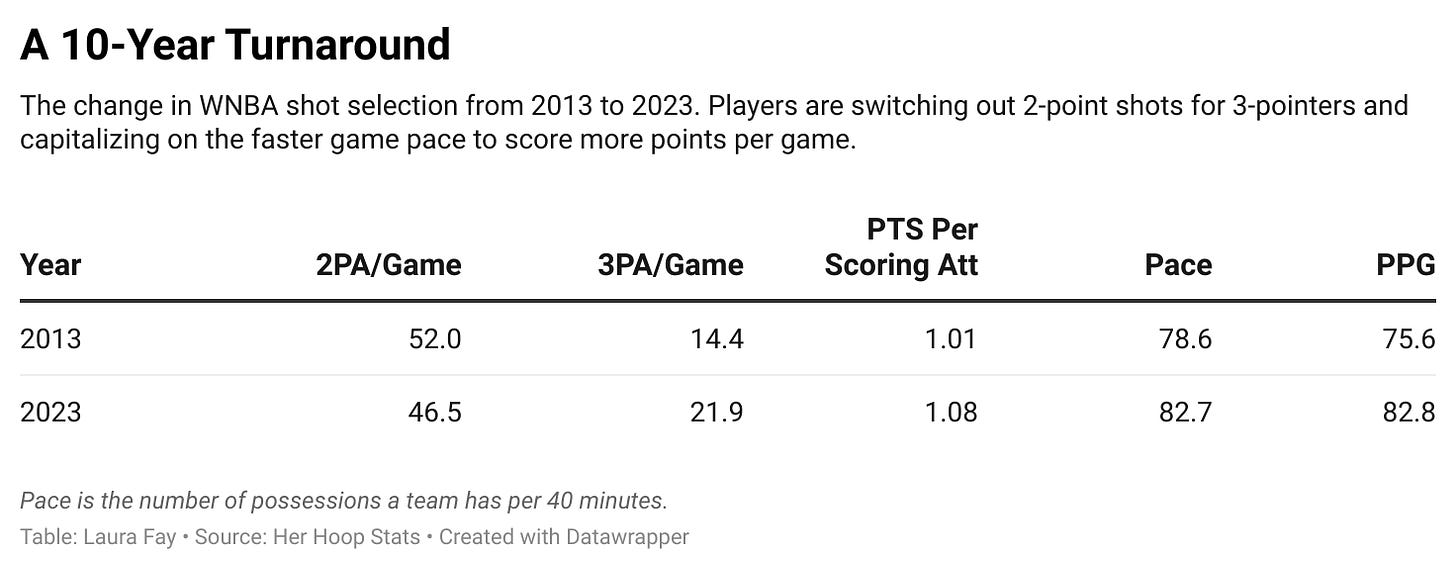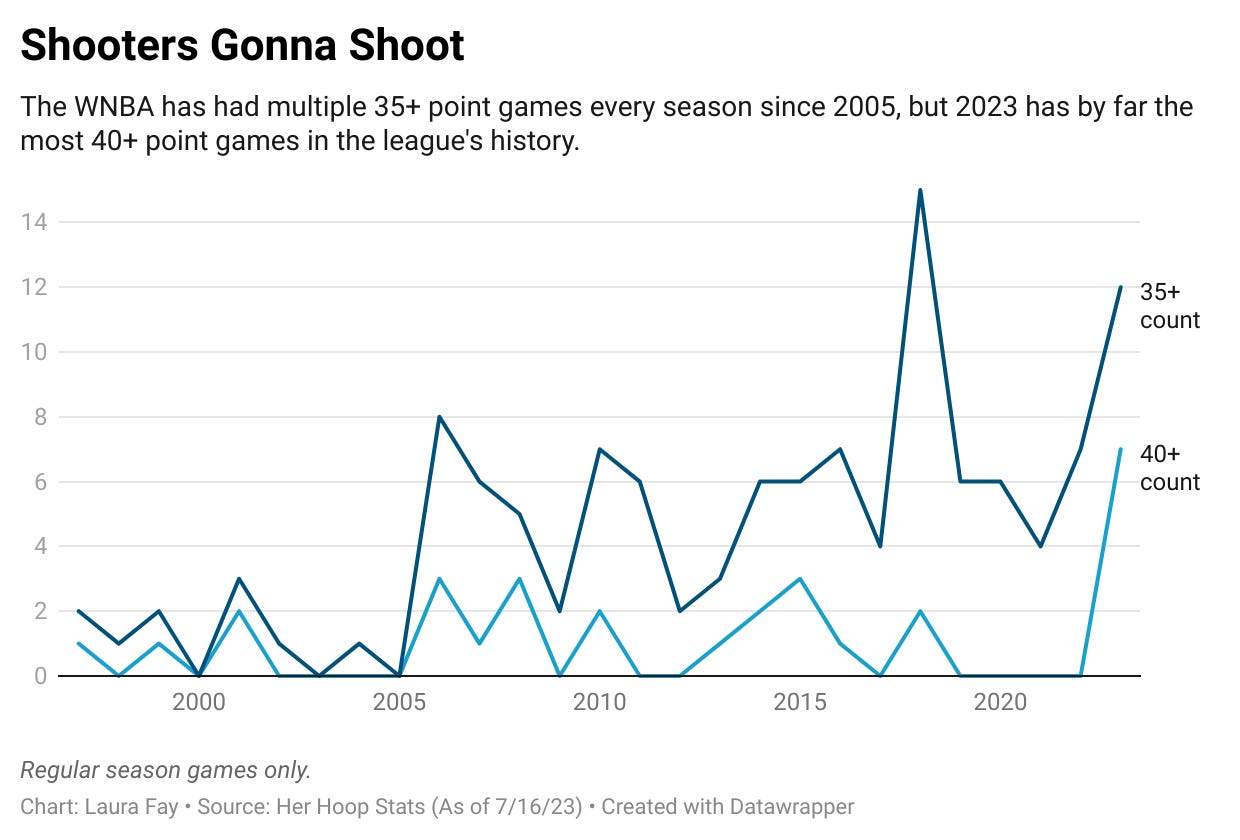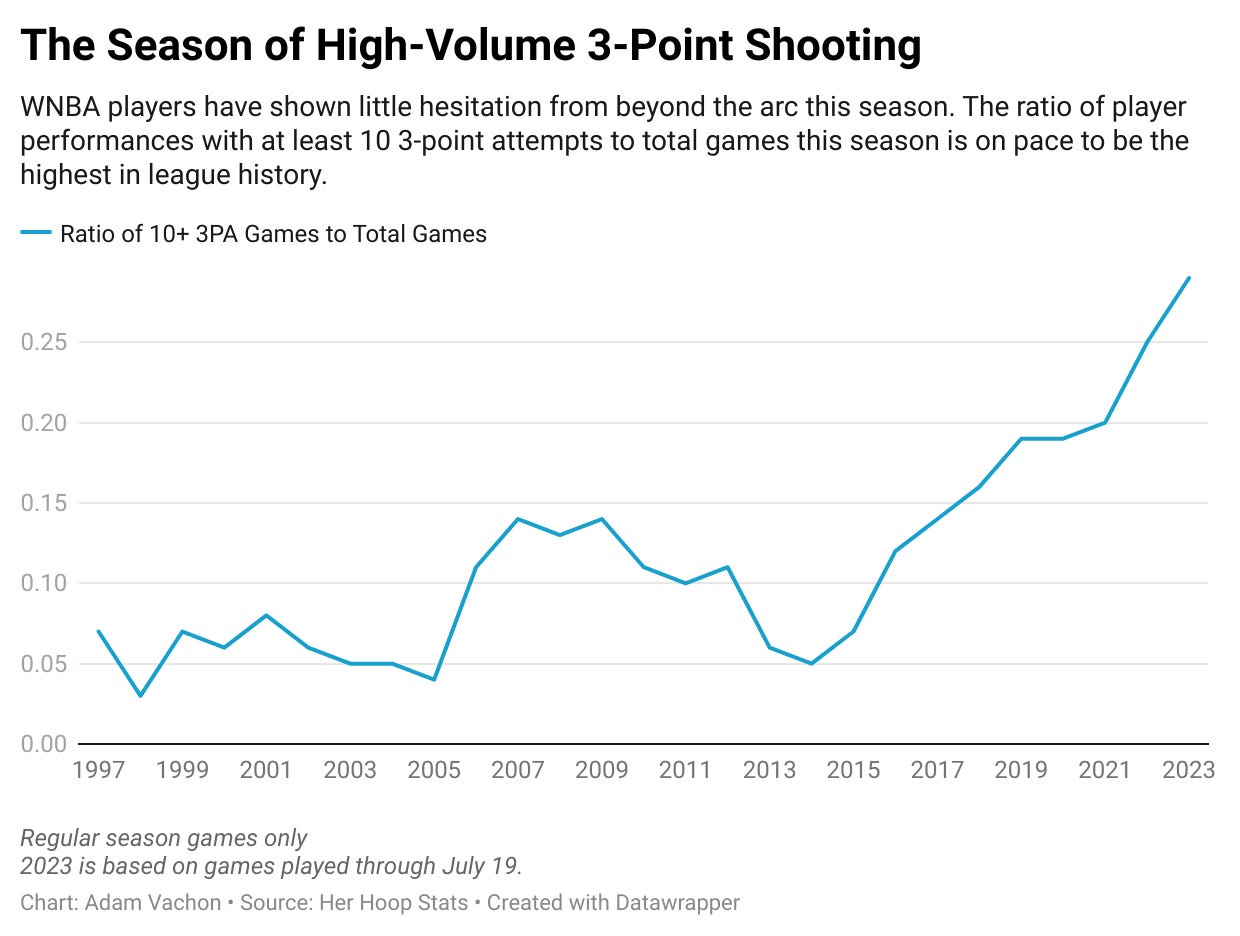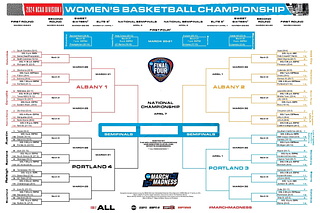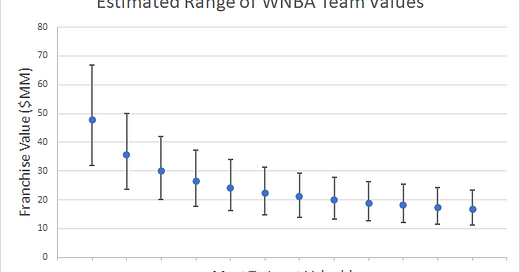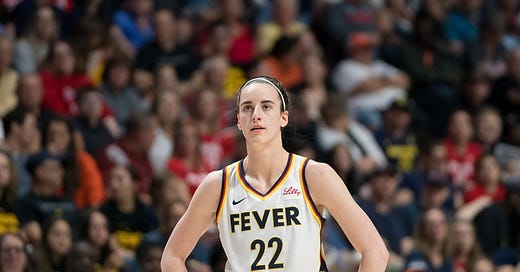
The WNBA's 40-Point Renaissance: A Perfect Storm of Factors Power a Scoring Surge
There have already been seven 40+ point games in 2023, more than the last seven seasons combined.
Thanks for reading the Her Hoop Stats Newsletter. If you like our work, be sure to check out our stats site, our podcast, and our social media accounts on Twitter, YouTube, Facebook, and Instagram. You can also buy Her Hoop Stats gear, such as laptop stickers, mugs, and shirts!
Haven’t subscribed to the Her Hoop Stats Newsletter yet?
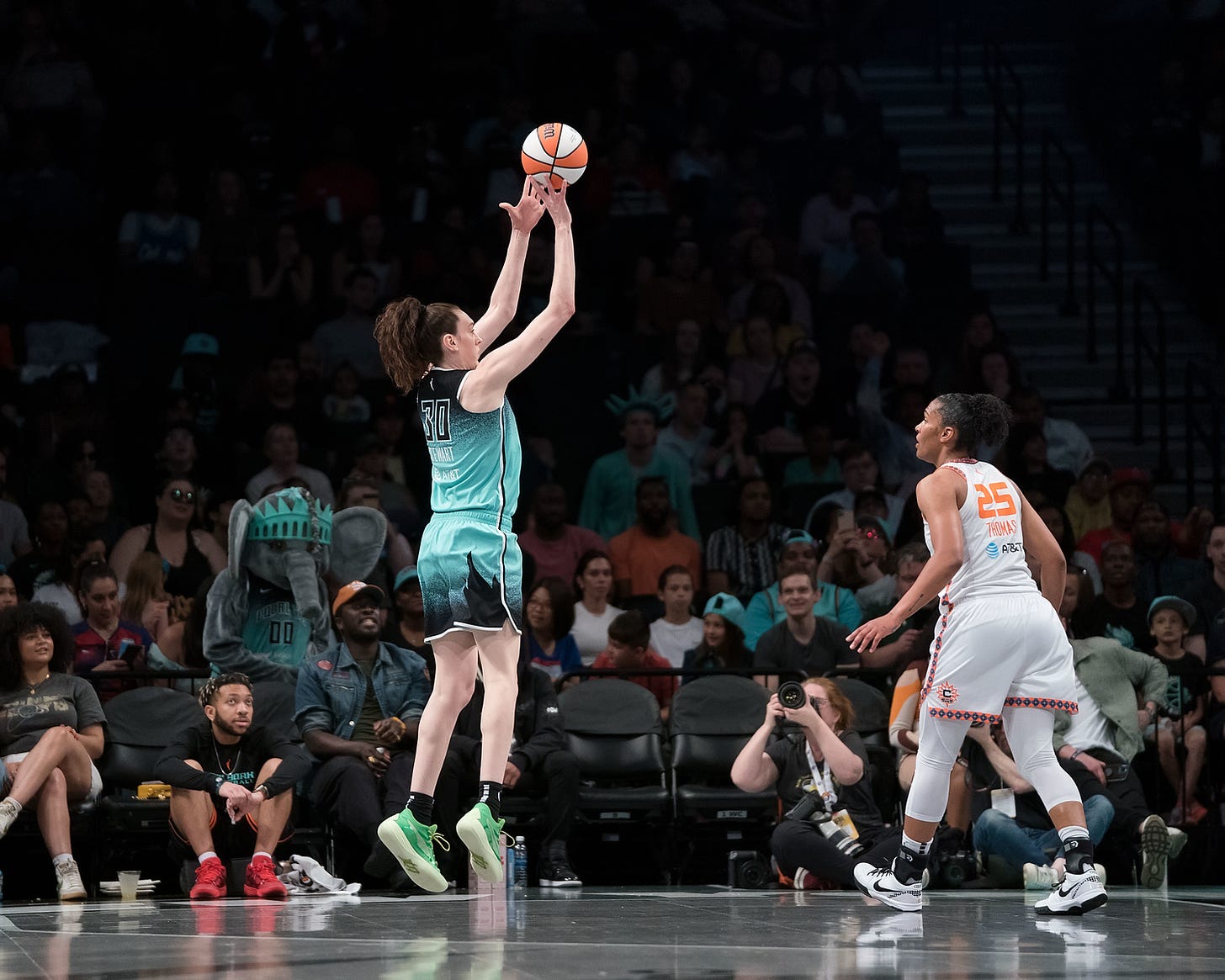
Even on her worst days, watching Breanna Stewart play basketball is always a treat. On her best days, she’s unstoppable. Such was the case during her home debut for the New York Liberty, where Stewart dropped 45 points for the first 40+ point game during the WNBA regular season in five years.
Stewart's stellar performance notched both a career-high and a franchise record, easily winning over the New York fans who showered her with "MVP" chants before the game had even ended. She also hit 40 in the fastest time ever—just three quarters, three minutes faster than her closest competitor—breaking a record that had been set when Stewart herself was just 12 years old.
Stewart still holds the record, but now it’s by just 25 seconds. That’s because in the two months since Stewart’s 40-piece, Jewell Loyd, Arike Ogunbowale, DeWanna Bonner, Rhyne Howard, and Kelsey Plum have also joined the club, combining for seven 40-point games with half a season still to play. Notably, Howard, Bonner, and Plum achieved their 40-point games in under 33 minutes, times that would have been league records before this season.
Even if the season ended today, 2023’s seven 40-point games would more than double the tally from any other season. The previous record for a season was three such games, achieved in 2006, 2008, and 2015. Any way you cut it, 2023 is an anomaly.
So, what’s driving the remarkable increase in individual output? In essence, it's a perfect storm of factors converging to let high-usage, high-accuracy shooters shine.
First and foremost, players are shooting more efficiently, as the WNBA’s points per scoring attempt has increased from 1.01 to 1.08 over the last decade. Secondly, the league’s pace of play, or the number of possessions each team uses per 40 minutes, has also steadily grown. Teams are currently averaging a record-high 82.7 possessions, giving players more opportunities to score than in previous years. And, given the change in shot distribution over the last decade, players are now cashing in with higher-value shots than ever before.
As pace and offensive efficiency have increased, teams have also exchanged 2-point shots for 3’s. The number of 2-point attempts in the WNBA has steadily decreased from a league-high 52.3 per game in 2014 to just 46.4 in 2023. Over the same period, the number of 3-point attempts has risen, with teams currently averaging 21.9 attempts from deep per game.
Those triples are also more likely to be assisted, as the league’s assist percentage (AST%) has risen. Defined as the percentage of field goals made by a team that were assisted, teams with high assist rates can scramble opponents’ defensive strategy and create more open looks. Per Synergy, catch-and-shoot jump shots, which are almost always assisted, produced 1.04 points per shot league-wide last season versus 0.79 points per shot on jump shots off the dribble.
3-point shots are also assisted at higher rates than 2-pointers, meaning players are, on average, getting more easy looks at higher-percentage shots than ever before. With more opportunity to rack up impressive numbers, it only follows that we’d see games with such remarkable scoring outputs.
Still, these metrics aren’t suddenly skyrocketing for the 2023 season. They’ve all been gradually increasing, but it wasn’t until this year that we started getting more 40-point performances.
That’s not to say there hasn’t been an increase in strong individual games. The WNBA has had at least two games where players scored 35+ points every year since 2005, and this season is well on pace to break 2018’s record of 15 such games. But unlike in 2018 when only 13% of those 35+ point games broke the 40-point barrier, 58% of 2023’s 35+ point games have.
So why have more high scoring games crossed the 40-point threshold this year? It’s difficult to point out a specific factor driving the turnaround. Some metrics, like 3PA/game, have significantly increased from the last high-scoring year in 2018 to 2023 (19. to 21.9). It’s possible these slight increases, when taken together, have pushed high scoring games into the 40+ region.
Individual 40+ point games also have a certain amount of luck built into them. They almost always require players to take more shots than they usually do, and shoot more efficiently from them. In 2023, more players than ever are taking more shots.
The ratio of 15+ FGA games to total games played this season is 2.02, meaning, on average, more than two players a game take 15+ shots. That’s the highest ratio in league history and 10% higher than the second-highest year, 2021. Similarly, the ratio of games with 10+ 3PA to total games played is also on pace to be a record-high. With more high-volume shooters taking their chances, there are more opportunities for players to break the 40-point barrier.
In particular, this season has two high-volume players who fit that bill perfectly.
Jewell Loyd is currently averaging 20.2 field-goal attempts per game, which would be a league record if maintained for the rest of the season. Loyd is admittedly getting less open looks—her shots are assisted at lower rates this year without Sue Bird running point—but has made up for it with the sheer volume of her attempts. Seattle lacks a secondary scoring threat, which means the offense essentially runs through Loyd.
She’s also averaging a league-leading 25.7 points per game, another would-be record should it hold, and put together a 41-point showing against Minnesota.
Dallas’s Arike Ogunbowale isn’t far behind. Well-known as a high-volume shooter, Ogunbowale’s 19.4 field-goal attempts per game this season are on track to rank fifth all-time (behind Loyd, Tina Charles in 2016 and 2021, and Diana Taurasi in 2006). Ogunbowale knocked down seven triples in her own 41-point performance last month.
Both Loyd and Ogunbowale have the ability to take over games, and each have extremely high usage rates. Loyd’s, at 32.6%, is the highest in the league and seventh all-time. Additionally, both players epitomize the kind of fast-paced, high-usage volume sharpshooter players primed to be successful with the league’s ever-evolving style of play, and their 40-point performances are evidence of that. The individual conditions the pair are working under this season make such high-scoring outings just that much likelier still.
Only time will tell if the WNBA’s 40-point renaissance will become a lasting trend. It’s possible that, like in 2018, the myriad of high-scoring games will regress to the mean over the next few years. But with a perfect storm of factors enabling high-scoring games and players capitalizing on that opportunity more than ever, the stage is set for more high-scoring outings in the near future.
All statistics based on games played through July 19th.
Thanks for reading the Her Hoop Stats Newsletter. If you like our work, be sure to check out our stats site, our podcast, and our social media accounts on Twitter, YouTube, Facebook, and Instagram.




